Learn how to handle and care for live lobsters at home with tips from the lobster experts — LobsterAnywhere.com.
Note our tips for storing lobsters apply mostly to hard-shell lobsters. Although soft-shell lobsters (lobsters that have shed their old shells) can be purchased locally, they are generally weak and fragile and do not store or ship well.
Page Contents
Live Lobsters Packed and Shipped

Your hand-selected lobsters are packed live with seawater-soaked newsprint or fresh seaweed to keep them moist, and frozen ice gels to keep them cold. Lobsters are shipped in extra thick insulated cooler. Learn more about how lobsters are shipped to you, plus our delivery costs.
DO NOT freeze live seafood: live lobster, mussels, oysters, steamers.
Recycle Your Seafood Cooler
The packing container (shipping cooler) and frozen gel packs are completely reusable! Save them for the beach!
My Maine Lobsters Just Arrived at My Doorstep — Now What?
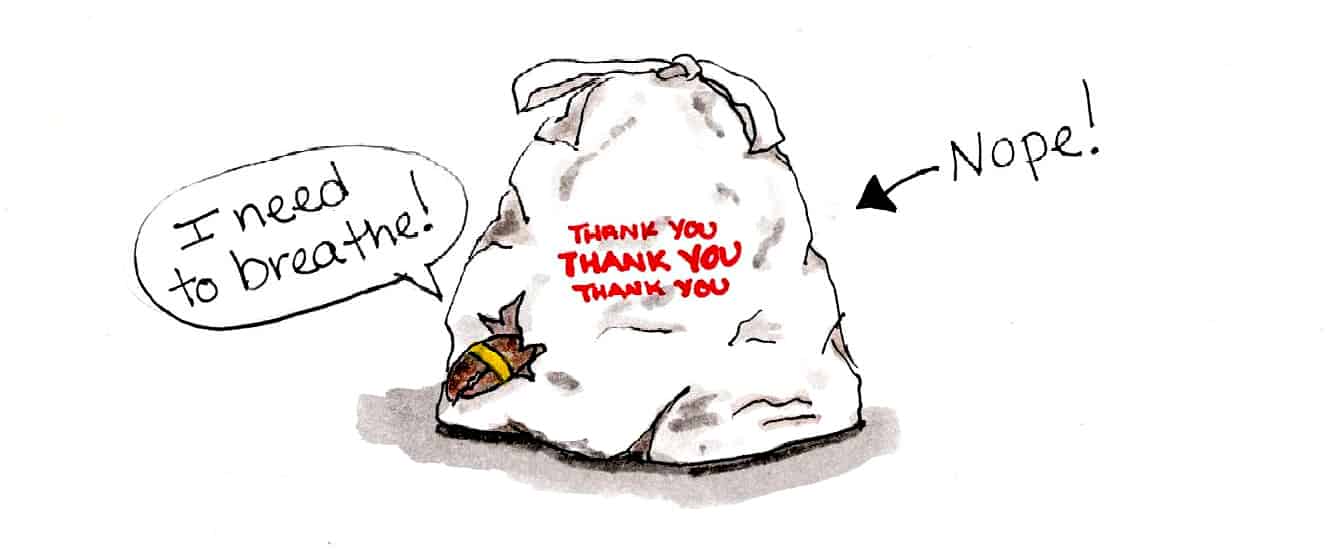
Do not store live lobsters in a sealed plastic bag (lobsters need to breath).
Do NOT store live lobsters in fresh or salt water, your freezer, in plastic bags (lobsters need to breath), or let them sit in melted ice. Packing them in ice creates a buildup of fresh water which can suffocate them (use bags of ice or frozen gel packs instead.)
Do not put lobsters in your aquarium or see if he can swim in the pool. Seriously!
Were you lucky enough to receive a special delivery from LobsterAnywhere? Here’s what to do:
- Refrigerate lobsters immediately, and keep them cold until you’re ready to cook them (best around 40 degrees F). The colder the lobster is, the lobster will become sluggish and won’t move around a lot. Don’t put them in your freezer.
- Keep lobsters moist with wet newspaper or seaweed that it was packed in. A dry lobster is an unhappy lobster.
- It’s best to cook lobsters the day they’re delivered. See below if you cannot cook your lobsters right away.
- Store lobsters in a strong paper bag or right in the lobster pot if you were lucky to receive one.
- When transferring lobsters, pick them up by the body, not the claws or the tail. To handle a live lobster, pick it up by the large shell just behind its head (the carapace shell). The lobster may wave its claws, flex its tail, or display only the slightest movement.
- If the lobsters are warm to the touch and there is a foul odor, contact LobsterAnywhere.com the day of delivery. Please see our Happy Cracking Guarantee.
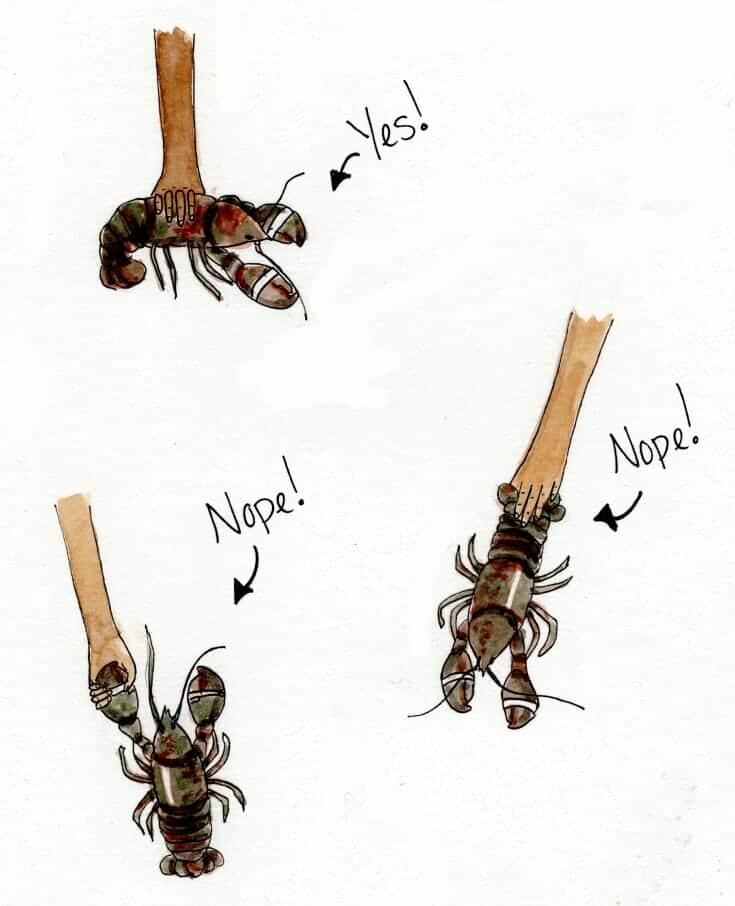
How to Hold a Lobster without Getting Pinched!
Lobsters will come to you with heavy rubber bands on their claws. The fisherman put those on as soon as the lobsters are removed from their traps. These bands are to protect the lobsters from damaging each other.
First things first, keep the bands on the claws! Both claws should be banded. (It’s up for debate of whether to take the bands off the lobster before cooking.)
To hold live lobsters without getting pinched by the claws, hold the lobster by the lower end of the bigger body shell (called the carapace) while letting the lobster head and claws hang down.
Be careful not to let your fingers go below the tail. The shell on the underside of the tail has some sharp edges, and may cut you if the lobster flips its tail as if it was swimming. That’s right, lobsters swim backwards by flipping that powerful tail. You have probably heard the old adage “crabs crawl sideways and lobsters swim back.”
Only pick up one lobster at at a time. Follow the rule: one hand, one lobster. Do not attempt to pick up several lobsters at a time. Also set lobsters down with care. Do not drop or toss them as you can easily damage them.
Lobster Rules – Dos and Don’ts of Handling Live Lobsters

DO — Refrigerate me when I arrive.
DO — Cook me as soon as possible, the fresher the better.
DO — Cook me even if I appear motionless. After cooking, my tail should curl under me and my meat should be firm
DO — Pick me up by the body, not the claws or tail.
DON’T — Remove my rubber bands around my claws until after cooking (unless you know what you’re doing!).
DON’T — Put me in fresh or salt water, your freezer, in plastic bags (I need to breathe), or let me sit in melted ice.
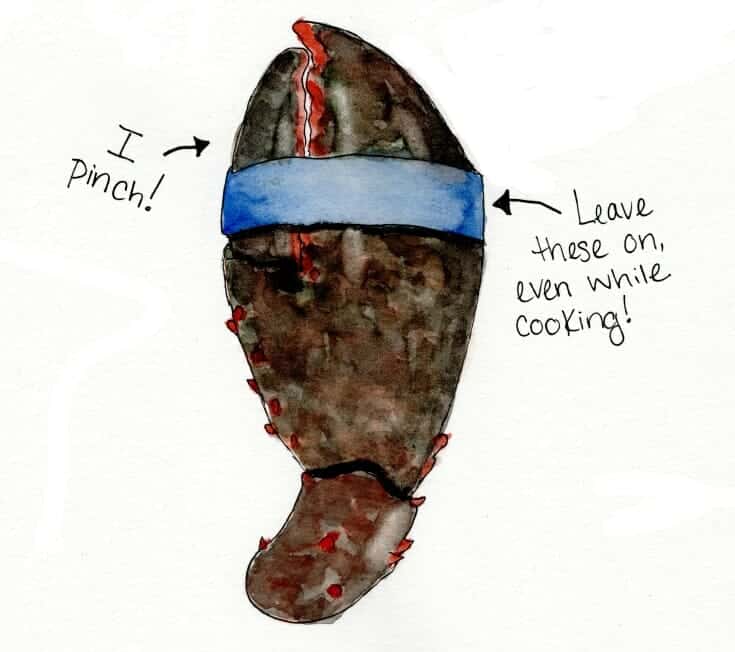
My Lobsters are not Moving or are Damaged?
Lobsters are packed to order, live and kicking and shipped overnight. Since they have traveled a long way they may have tired. (Note that cold temperatures make lobsters sluggish.) Live lobsters will move very slowly while cold, but come to life once it starts to warm up on your kitchen counter.
Cook lobsters even if they appear motionless. This is also true if a lobster is damaged or drops a claw in transport.
In the unlikely event that a lobster has died, it is usually acceptable to cook if it is still cold to the touch and if the other lobsters in the shipment are still alive. Cook them up! The tail of the lobster is the best indicator of its freshness: it should curl under the body and be somewhat firm not watery or mushy when cooked.
How long Can You Store and Keep Live Lobsters Before Cooking?
Once your live lobster arrives how long can you keep it before it needs to be cooked? What if you cannot cook your lobsters the same day?
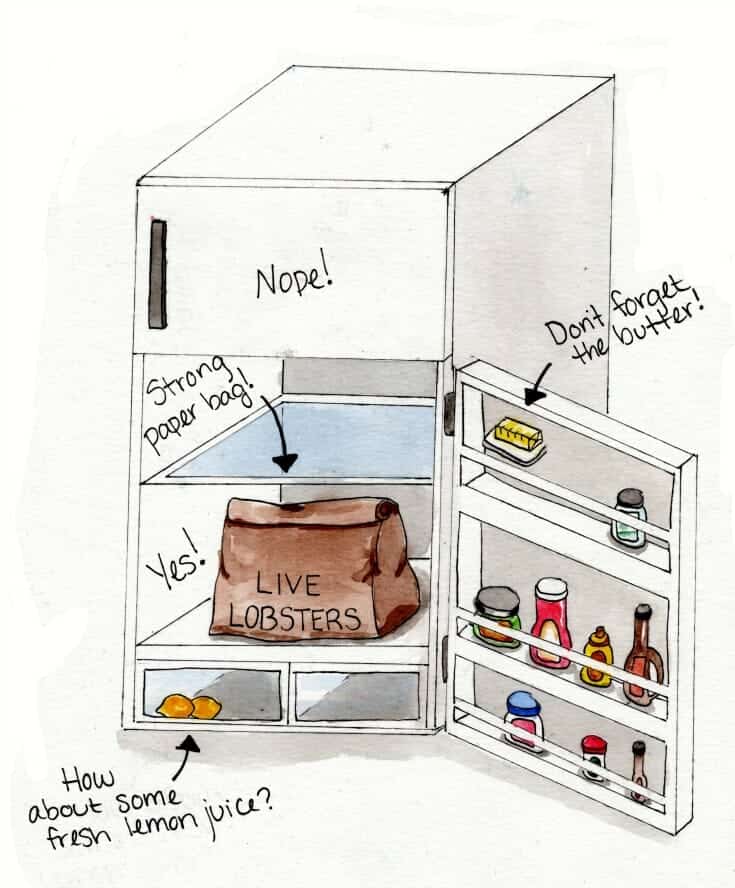
Our lobsters are very hardy and have been know to last up to 36 hours out of sea water, but we cannot guarantee it. We always suggest cooking your lobsters the day they are delivered.
You can store live lobsters overnight, one night, in your refrigerator. Keep them upright, moist, and cold and you’re good to go!
The best way to keep lobsters alive for up to 24 hours is to store them with damp newspaper (or fresh seaweed) in the coldest part of the refrigerator (usually the lowest shelf at the back or in the meat keeper). Keep lobsters in a loose paper bag or in the shipping container. Don’t even think about the freezer!
Periodically check up on your lobsters, If the lobsters are still moving, you may delay cooking, but if they begin to show little or no movement they need to go right into the pot! Follow instructions below.
Packing and Keeping Lobsters in a Cooler to Go
Pack and surround the lobsters with sea-water soaked newsprint and/or seaweed and frozen gel packs. Try to pack for a snug fit as you do not want the lobsters smashing up against each other in transport.
If you do not have frozen gels packs you can use bags of ice. Double bag the ice to keep it from leaking. Never let live lobsters rest in fresh water from melted ice as this can cause osmotic shock, suffocation and death.
Cooking Lobsters and Eating Later
If for some reason you find that you cannot cook the lobsters for more than a day, you may partially cook them. After you have par-cooked them, submerge in cold water for 3 minutes, drain, and refrigerate. You can finish cooking them any time up to 48 hours later.
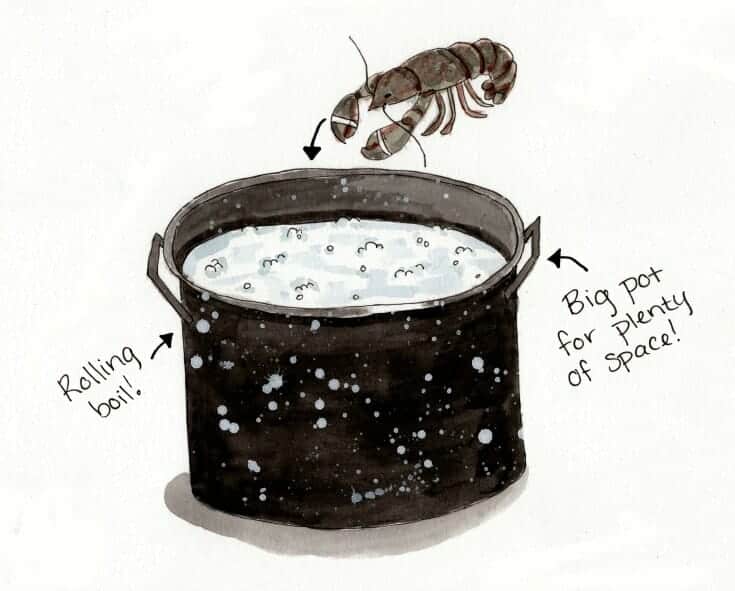
Alternatively, you can cook lobsters and pick the meat. Cooked lobster meat may be refrigerated in an airtight container for 2-3 days, or for months if frozen.
Break Down Fresh Killed Lobster Before Storing
It is important to break down a fresh dispatched lobster before storing in the refrigerator. Separate the tail and claws from the body to prevent the tail from becoming mushy. As Cooks Science notes the digestive enzymes found in the lobster‘s body (hepto-pancreas) will break down the proteins in the tail turning it mushy.
Need Help Cooking Live Lobster?
Check out our Guide for Cooking Live Lobster at Home.
Quick FAQs on How to Handle Live Lobsters.
Lobsters claws are powerful in the grasping direction. They can cut your finger if you are not careful. The claw bands will protect you and also prevent lobsters from injuring themselves or other lobsters. Although the claws are strong in the grasping position, they are week in the opposite direction. We suggest leaving the bands on the claws until after it is fully cooked.
Hold the live lobster by the lower end of the bigger body shell (called the carapace) while allowing the lobster head and claws to hang down. Be careful not to let your fingers go below the tail. The underpart of the tail can have some sharp edges and will sometimes flip its powerful tail.
A good hard-shell lobster can live up to 36 hours out of water if kept cool, moist and refrigerated. Since lobster is a gill breather wet newspaper and/or seaweed helps keep them moist. Since lobsters are seawater creatures never store them in fresh water. If you need to use ice to keep lobsters cold make sure the ice is double bagged. LobsterAnywhere suggests cooking your lobster the day they are received.
While lobster can live out of water for a day of more when stored in the refrigerator between 36 and 45 degree, for best result we suggest that you cook them the day they arrive.
The answer to your question is probably “yes,” unless of course, the supermarket is in Belfast, ME, and your home is in Berkeley, CA! Lobster meat does not take long to spoil after the lobster dies. As long as there isn’t an unusual odor, cooking and eating the lobster is probably ok. However, there are a couple of things to watch for to be certain. If the Lobster is safe, the tail will be curled tightly after cooking, and the meat inside will be firm. If either of these conditions are not present, don’t take the risk!
It’s best to partially cook lobsters and reheat. You may keep them refrigerated for up to three days.
The shade varies a little from lobster to lobster, but they are generally a dark blue-green in the wild.
The best time to cut your rubber band is after the Lobster is already cooked. If you do it too soon, you might get pinched!
Refrigerate lobsters immediately, and keep them cold until you’re ready to cook them (best around 40 degrees F). The colder the lobster is, the lobster will become sluggish and won’t move around a lot. Don’t put them in your freezer.
Keep lobsters moist with wet newspaper or seaweed that it was packed in. A dry lobster is an unhappy lobster.
It’s best to cook lobsters the day they’re delivered. See below if you cannot cook your lobsters right away.
References
Crosby, Guy. Cooks Science: How to Unlock Flavor in 50 of Our Favorite Ingredients. Americas Test Kitchen, 2016.

[…] Refrigerate your lobster immediately, at around 40 degrees Fahrenheit, until you’re ready to cook it. Keep the lobster on the bottom shelf of your fridge to avoid contaminating any other food. […]
I used to dive for Live lobster all the time in the Azores as well as in Italy and in the Mediterain. I always put them in the freezer until I was ready to eat what I couldn’t after a dive no matter where in the world I ventured. The meat did not taste as fresh although very good. I also buy my Live Lobster when I go in August to the Lobster Festival and put them on dry ice with brown packing paper between them. I have to drive back to Wisconsin and then I put them in an air sealed pack and in the freezer for when I want to eat them and never had a problem. They were still delicious. This might be good for people traveling through your area?
Your diving and catching warm water lobsters (Rock lobster or spiny lobster.) In New England, it’s cold-water Maine lobster (Homarus americanus). Dry ice would kill a live Maine lobster instantly. We actually ship them with frozen gel packs to keep them cold, not frozen so they are fresh right before you cook them. But you dry ice is a good way to keep things frozen solid at -109 degrees. This is what we ship our frozen, raw lobster tails and meat with. Thanks for visiting!
Prices for lobsters and shipping to Florida, please.
See for live lobster prices. For shipping quote simply add to the trap/cart.